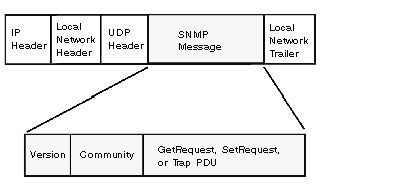The Object Identifier (OID)
In the ASN.1 Naming Scheme example, the MIB object identified by the notation 1.3.6.1.2.2.4.3 is referred to as the . All OIDs can be envisioned as part of a tree structure which begins at the root (ISO) and branches out with each subtree identified by an integer.
SNMP uses Protocol Data Units (PDUs) to carry the requests and responses, between the manager and the agents, for the information contained in an OID.
As the following figure shows, the SNMP message is the innermost part of a typical network transmission frame.
The PDUs within the SNMP initiate the communication between the manager and the agents.
The SNMP installed on your Momentum 170ENT11001 Ethernet communication adapter uses the following three PDUs.
-
GetRequest
-
SetRequest
-
Trap
The GetRequest (shortened to Get) PDU is used by the SNMP manager to retrieve the value of one or more objects (OIDs) from an agent.
The SetRequest (shortened to Set) PDU is used by the SNMP manager to assign a value to one or more objects (OIDs) residing in an agent.
The Trap PDU is used by the agent to alert the manager that a predefined event has occurred.
Version & Community Identifiers
The version identifies the version number of the SNMP software being used by the manager and the agent. Your adapter supports Version 2 of the SNMP. The community is an identifier that you assign to your SNMP network. If community names for the manager and the agent do not agree, the agent will send an authentication failure trap message to the manager. If the community names and version number agree, the SNMP PDU will be processed.
Your Momentum 170ENT11001 adapter can be configured to send an authentication trap to two SNMP managers if it receives a community name in a Get/Set request that does not match the configured name. Also, you can configure the Sys Contact and Sys Location via the configuration page in the adapterís embedded Web pages.
